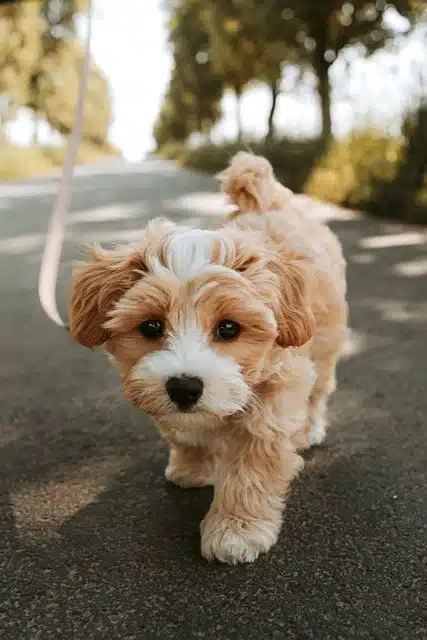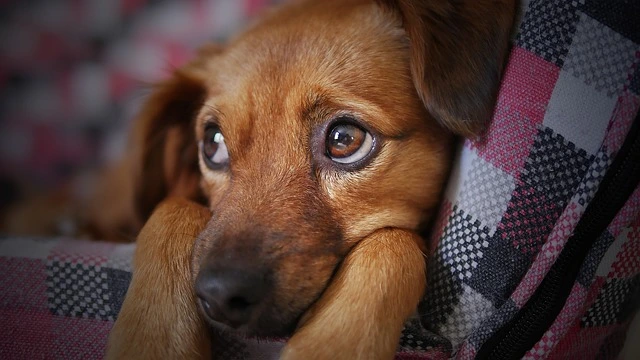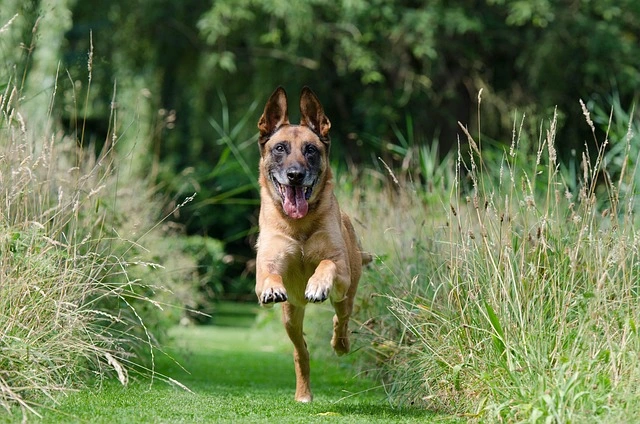Bringing home a puppy is pure magic—until you clip on that leash. Suddenly, what you pictured as a sweet stroll looks more like slapstick theater: your pup lunges at every drifting leaf, freezes like a statue in the middle of the sidewalk, or wraps you up like a maypole. Leash training isn’t just about saving your back and shoulders (though that helps); it’s about giving your dog the skills to enjoy safe, calm adventures with you for years to come.

Table of Contents
Quick Answer
Leash training a puppy simply means teaching them to stroll at your side without the pulling, zig-zagging, or sudden sit-downs. Most pups get the hang of it in about three to six weeks if you stay consistent and keep things positive. Start in a quiet, low-distraction space like your living room, then gradually move to busier areas as your puppy grows more confident. Done well, it makes walks safer and turns them into something you both look forward to.
TL;DR: Grab the right gear, begin indoors, reward good behavior, and slowly add distractions. Stick with it, and most puppies are walking politely within a month or so.
Why Leash Training Matters
Leash training isn’t just about making walks easier—it’s about keeping your puppy safe. A young dog without leash manners can dart into the street, gulp down something they shouldn’t, or run nose-first into a less-than-friendly dog. On top of that, constant pulling puts stress on a puppy’s growing body. For little breeds especially, too much pressure on the neck can cause long-term damage.
But safety is only part of the picture. A puppy who learns leash skills early also gains confidence. Boundaries actually make dogs feel more secure, and those first weeks on the leash set the tone for how you’ll communicate with each other for years to come. A well-trained dog tends to have more freedom, too—welcome in cafés, parks, and on family trips instead of being left behind.
And then there’s the mental side. Walks aren’t just bathroom breaks; they’re workouts for the brain. Exploring new smells and sights keeps your puppy stimulated, which means less chewing on your shoes, fewer nuisance barks, and a calmer pup when you leave the house. At the end of the day, a tired puppy really is a happy puppy.
Understanding Your Puppy’s Perspective
Think of leash training from your puppy’s perspective. That strip of fabric feels strange to a creature built to roam, so pulling or zigzagging isn’t defiance—it’s confusion. Walks also bombard puppies with smells and sights we can’t imagine, which explains their constant “distractions.”
Age matters too. Very young pups have short attention spans and limited coordination, but starting with brief, positive sessions builds a solid foundation. And don’t forget breed quirks: hounds follow scents, herders may circle you, and terriers react to movement. Working with those instincts makes training smoother for both of you.
Tools & Product Recommendations
Puppy-Friendly Harness
Perfect for first-time puppy parents dealing with pullers, this front-clip harness gently redirects your pup’s momentum when they lunge forward. The belly strap’s contrasting color makes it intuitive to put on correctly even when you’re half-awake for those early morning potty breaks. The four adjustment points create a custom fit for growing puppies, though the straps can sometimes loosen during particularly energetic walks. Ideal for medium to large breed puppies who need gentle guidance without throat pressure.
Training Leash for Puppies
This 15-foot training leash gives your pup room to explore while keeping you in control—ideal for those early socialization months. The padded handle saves your hands if your puppy lunges after a squirrel, and the reflective stitching makes evening or early-morning walks safer. The swivel clip helps prevent tangles, though the extra length can feel clumsy in tight spaces. It’s a great pick for recall practice or easing into longer-distance training.
Treat Pouch for Training
This hands-free treat pouch keeps rewards right where you need them. The hinged top snaps open for quick access during training and shuts tight afterward—no surprise treats in the washing machine. You can clip or hook it to your belt, though it feels a little bulky under a jacket. Ideal for leash training walks when you want fast, fumble-free rewards.
Puppy Training Treats
These soft, bite-sized treats are perfect for rapid rewards on training walks. They don’t crumble in your pouch, and puppies can eat them quickly without losing focus. At just 3 calories each, you can use plenty without overfeeding. The resealable bag helps keep them fresh, but they dry out fast if left open. Great for any pup that needs frequent, high-value rewards.
Step-by-Step Leash Training Tutorial
1. Introduce the Collar/Harness Gradually
Before heading out, let your puppy adjust to wearing a collar or harness. Start with just a couple of minutes during playtime or meals, then gradually extend the time over a few days. If your pup scratches, rolls, or freezes up, slow down—the goal is for the harness to mean fun, not frustration.
Pro tip: A dab of peanut butter on your finger works wonders. While your pup licks away, you can clip on the harness without a fuss.
2. Introduce the Leash Indoors First
Once the harness feels normal, clip on the leash and let your puppy drag it around in a safe room while you supervise. This way, they learn the sensation without pressure. After a day or two, pick up the handle and simply follow along. Don’t steer just yet—let your pup lead. It shows them the leash is a connection, not a restraint.
3. Build the Basics: Attention and Following
Start indoors where it’s quiet. Hold the leash loosely and wait for your puppy to glance your way. The second they do, say “yes!” and reward at your side. Take a step back, let them follow, then reward again. Slowly add a few more steps in different directions, always marking and treating when they stay with you.
I once worked with a Labrador named Beau who caught on in just two five-minute sessions thanks to his love of snacks. Most pups need a few days of short, consistent practice before it really clicks.
4. Shape Loose-Leash Walking
Decide which side you want your puppy on (traditionally the left, but consistency matters more than the side). Hold a treat by your leg on that side and take a few steps forward. When your pup stays beside you without pulling, mark and reward. Gradually stretch the number of steps before the next treat so they learn that their “spot” is right by your side.
A clicker can help nail the timing, but praise works too. With a week or so of short daily sessions, most puppies start choosing to walk in position on their own.
5. Mix Up Your Directions
Once your puppy can stick with you for a handful of steps, keep things interesting by switching it up—turn right, left, or even do a full U-turn. Praise and reward when they follow along. It teaches your pup to pay attention to you instead of marching ahead on autopilot, and it keeps walks mentally engaging. Pro tip: if your dog walks on your left, turn left into them rather than away—this prevents the leash from tightening and makes the turn smoother.
6. Move Outside, Slowly
When things are going well indoors, head to the yard or another quiet outdoor spot. Don’t be surprised if your puppy “forgets” their manners at first—outside is full of distractions. Keep sessions short, go back a step if needed, and build up gradually. Once they’re solid in the yard, try a quiet sidewalk or park during calm hours, then slowly increase the challenge. For many pups, this step-by-step transition takes a couple of weeks.
7. Work Through Distractions
Now for the tough part: distractions. Start small (a person walking by) and work toward bigger temptations like dogs or squirrels. Use extra-tasty treats when the challenge is higher. Distance is key—if your pup can stay focused at 50 feet but not 20, stick with 50 and close the gap over time. For those can’t-resist moments, try the “find it” game: toss a few treats on the ground and let them sniff around. It channels their instincts while bringing their focus back to you.
Quick Comparison of Leash Training Methods
Traditional Approach
- Pros: Simple, focuses on position and correction.
- Cons: Can create stress or pushback in sensitive pups.
- Best for: Confident puppies with experienced handlers.
Positive Reinforcement
- Pros: Builds happy associations, strengthens the bond, gentle.
- Cons: Needs patience and consistent timing.
- Best for: Most puppies, especially shy or easily overstimulated ones.
Lure and Reward
- Pros: Clear, intuitive, gives instant success.
- Cons: Puppies may depend on visible treats at first.
- Best for: Young pups and food-loving breeds in the early stages.
Gear & Training by Size
Small Breeds (Chihuahua, Yorkie, Maltese)
- Start 8–10 weeks. Use a lightweight harness and 6′ leash. Keep sessions tiny (2–3 minutes).
Medium Breeds (Beagle, Cocker Spaniel, Corgi)
- Start 8–12 weeks. Use a Y- or front-clip harness. Focus on impulse control with 5-minute sessions.
Large Breeds (Lab, Golden Retriever, German Shepherd)
- Start 8–12 weeks. A sturdy front-clip harness helps prevent pulling habits. Teach loose-leash skills early.
Giant Breeds (Great Dane, Bernese Mountain Dog)
- Start 10–12 weeks. Use a padded front-clip harness. Prioritize polite walking before they get too strong, and protect growing joints.
Common Mistakes (and Fixes)
Inconsistency: If pulling sometimes works, your puppy will keep trying. Fix: Set rules and make sure everyone sticks to them.
Too many distractions too soon: Don’t expect focus around squirrels before they’ve mastered basics indoors. Fix: Progress step by step.
Overdoing it: Puppies tire fast. Fix: Follow the “5 minutes per month of age” rule, twice a day.
Tightening the leash early: This tells your puppy something exciting is coming. Fix: Keep the leash loose and stay calm.
Rewarding in the wrong spot: Treats given out front encourage pulling. Fix: Reward only at your side.
Rushing progress: Leash manners take weeks, not days. Fix: Expect lots of repetitions in different places—4–6 weeks for most pups.
Punishing fear: Freezing or backing away is fear, not stubbornness. Fix: Pair scary things with treats and distance until they feel safe.
Troubleshooting (If/Then)
If your puppy bites the leash, then redirect to an appropriate toy and continue walking when they release. For persistent leash biters, try coating the leash with a bitter apple spray or use a chain leash section near the collar (the texture is less appealing to chew).
If your puppy sits and refuses to move, then avoid dragging (which teaches opposition) and instead use excitement, squeaky toys, or kneel and call them enthusiastically. Once moving, reward generously.
If your puppy lunges toward other dogs, then work on maintaining distance (start at 50+ feet if needed) and reward calm behavior in their presence. Gradually decrease distance as tolerance improves.
If your puppy zigzags and sniffs everything, then designate specific “sniff breaks” during walks. Use a release cue like “go sniff” for these breaks, then a attention cue like “let’s go” to resume walking.
If your puppy pulls constantly despite training, then try stopping completely when the leash tightens. Only proceed when they create slack, even if it takes several minutes initially. Consistency here is crucial.
If your puppy is fine on walks but goes ballistic at the sight of the leash, then revisit the foundation. The leash has developed negative associations that need to be systematically replaced with positive ones through gradual re-introduction.
If your previously trained puppy regresses during adolescence, then don’t panic. This is normal around 6-10 months. Return to easier environments, higher-value rewards, and shorter training sessions until the teenager phase passes.
When to See a Professional
While most puppies respond well to consistent training, some situations warrant professional help:
- Extreme fearfulness that doesn’t improve with gentle exposure
- Aggressive reactions toward other dogs or people while on leash
- Severe pulling that creates safety concerns, especially with large breeds
- No improvement after 3-4 weeks of consistent training
- Any sudden change in walking behavior that might indicate pain or discomfort
Look for trainers who use positive reinforcement methods and have experience with puppies specifically. A certified professional dog trainer (CPDT) or applied animal behaviorist can provide tailored guidance for challenging cases.
FAQs
At what age should I start leash training my puppy?
You can begin introducing a lightweight collar or harness as early as 8 weeks, with formal leash training starting around 10-12 weeks. Early positive experiences with walking equipment set the foundation for successful training.
How long should leash training sessions be for a puppy?
Keep sessions short and sweet—3-5 minutes for puppies under 4 months, gradually increasing to 10-15 minutes for older puppies. Multiple short sessions throughout the day are more effective than one long session.
Should I use a collar or harness for leash training?
For most puppies, a properly fitted harness is safer and more comfortable, especially for small breeds vulnerable to tracheal damage. Front-clip harnesses provide better control for pullers without causing pain.
My puppy walks well until we see another dog, then goes crazy. Help!
This reactivity is common and requires systematic desensitization. Start at a distance where your puppy notices the other dog but can still focus on you, then reward calm behavior and gradually decrease distance over multiple sessions.
How long does it typically take to fully leash train a puppy?
Most puppies develop reliable leash skills within 4-6 weeks of consistent training, but expect occasional regression during fear periods or adolescence. Full reliability around high-level distractions may take 4-6 months.
Is it okay to let my puppy sniff during walks?
Absolutely! Sniffing is mentally stimulating and a natural dog behavior. The key is teaching your puppy when it’s appropriate to sniff (using a release cue) versus when you need their attention on walking.
My puppy was walking nicely but suddenly started pulling again. What happened?
This regression is normal during developmental fear periods (around 8-10 weeks and 6-8 months) or adolescence. Return to easier environments and more frequent rewards temporarily, then gradually rebuild difficulty.
Conclusion
Leash training a puppy requires patience, consistency, and understanding—but the payoff is enormous. A well-trained walker isn’t just a pleasure to walk with; they’re a dog who can safely join you on countless adventures throughout their life. Remember that puppies learn at their own pace, and progress isn’t always linear. Those moments of backsliding are normal and temporary.
The time you invest now in proper leash manners will save countless hours of frustration later. More importantly, it builds communication and trust with your new companion. Focus on making walking a joyful, cooperative activity rather than a battle of wills. When challenges arise (and they will), return to easier environments and simpler steps rather than pushing through with frustration.
Your goal isn’t just a dog who doesn’t pull—it’s a confident companion who understands how to navigate the world safely by your side. With consistency, positive reinforcement, and the right equipment, you’ll be enjoying stress-free strolls together before you know it.

